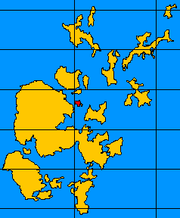Gairsay
|
|
Gairsay is an island in Orkney, Scotland. In Norse times Gairsay was the winter home of the Norse chieftain Svein Asleifarson, whose house was called Langskaill. Here he kept 80 armed men. After the spring planting had been done Svein would go on Viking raids, mostly around the Irish Sea. He died attempting to conquer Dublin in the year 1171 [Liv Kjorsvik Schei and Gunnie Moberg, The Orkney story (New York: Hippocrene Books, 1985), p.207-8]. In the seventeenth century Langskaill was the home to Sir William Craigie of Gairsay, not to be confused with the prominent lexicographer of the same name.
Following are some passages from 19th century Scottish gazetteers about the island of Gairsay:
"GAIRSA (sic), one of the Orkneys, constituting part of the parish of Rendal (sic), from which it is separated by a strait about 1 1/2 mile broad. This island is about 2 miles long, and 1 broad; the greater part of it consists of a conical hill of considerable altitude. The whole of its west side is steep; but towards the east, it is both plain and fertile; and in that quarter, as well as on the south, the lands are well-cultivated. It contained 69 inhabitants in 1838. Close by the south shore stand the remains of an old house which seems formerly to have possessed some degree of elegance and strength, and was the residence of Sir William Craigie, and others of that name and family. here is a small harbour, called the Mill-burn, perfectly secured on all sides by the island itself; and a small holm, which covers the entrance to the south, leaving a passage on each side of it to the anchoring ground." [The Topographical, statistical, and historical gazetteer of Scotland. (Glasgow: A. Fullarton, n.d. (ca.1840), p.596]
"GAIRSAY, an island, in the parish of Evie and Rendall, county of Orkney; containing 71 inhabitants. This is an isle of the Orkney group, about four miles in circuit, and separated by a strait from Rendall. It consists chiefly of a conical hill of considerable altitude; the whole of the west side is pretty steep, but towards the east it is more level and fertile, and in this quarter, and in the south, the lands are tolerably well cultivated. Here is a small harbour called the Mill-Burn, perfectly secured on all sides by the island itself, and by a holm, which covers the entrance to the south, leaving a passage on each side of it to the anchoring ground." [Samuel Lewis, A Topographical dictionary of Scotland, comprising the several counties, islands, cities, burgh and market towns, parishes, and principal villages. (London: S. Lewis & Co., 1846), p.458]
According to census records, in 1831 there were 69 people living on Gairsay, and 71 people in 15 families in 1841. In the 1841 census a note was made that stated: "The island used to be noted for the quantity of kelp made on it. None has for some years been made on it." In 1851 there were only 41 people in 6 families living on the island. Ten years later the population was down to 34 people in only 5 families. By 1881 that number was 37 people in only 4 families. In recent years the island was owned by one family, named McGill, who purchased the island in 1968 and now farm it and who issue their own postage stamps. Valerie McGill writes that "in 1928 there were 79 folk on Gairsay, mainly tenant farmers, a Harold Clouston bought the property, kicked out all the tenants but did not farm himself, just used the island as a summer residence. It is a very beautiful island, 1 mile from the mainland of Orkney with a 360' hill in the middle, heather clad, seals, otters, birds prolific."

